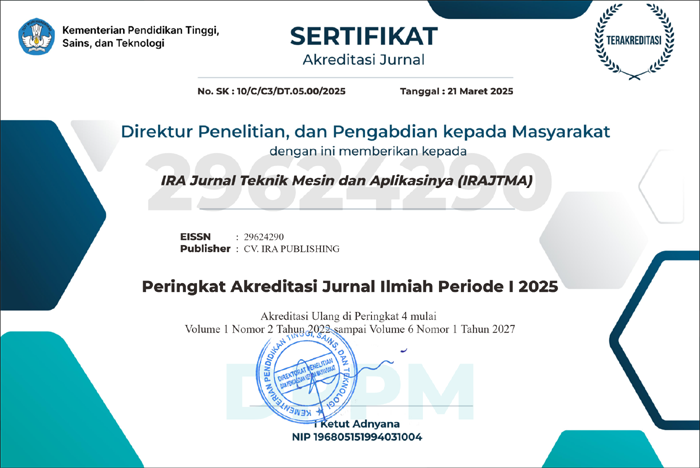The Effect of the Combination of Candlenut Shells and Shells Coconut Against Calorific Value of Briquettes
DOI:
https://doi.org/10.56862/irajtma.v1i2.22Keywords:
Biomass, Pecan Shell, Coconut Shell, Calorific Value BriquettesAbstract
Energy demand in the world continues to increase in line with population growth and economic growth. Biomass is a renewable energy source that comes from living things which include plants, animals and their by-products such as garden waste, crops and so on. The mass of 0.0002 kg is the mass of the briquettes allowed on the bomb calorimeter test equipment, the test was carried out nine times for each variation of the mixture, where there were three variations of the mixture in the test, namely level 1 variation of the mixture of 25% candlenut shell charcoal, 65% coconut shell charcoal and 10% starch, level 2 variation mix 65% candlenut shell charcoal, 25% coconut shell charcoal and 10% starch, level 3 mixed variation 45% candlenut shell charcoal, 45% coconut shell charcoal and 10% starch . Briquettes are fuel that is compacted and formed in molds. The results of the analysis data were obtained using Minitab20 with product optimization of the Taguchi method. The optimum LHV value of the briquettes recommended by Taguchi was obtained from the mixed variation level 2 briquettes, namely 65% candlenut shell charcoal and 25% coconut shell charcoal with an adhesive concentration of 10%, obtained a heat of 23884.252 kJ/kg against the uncontrol factor during briquette drying, namely speed wind 0.5 m/s, ambient temperature 37.4 °C, with air humidity 46% while in laboratory observations the optimum LHV value was in level 3 mixed variation briquettes with a value of 32054.208 kJ/kg with mixed variations namely 45% candlenut shell and 45% coconut shell charcoal with an adhesive concentration of 10% starch.
References
Almu, M. Afif, S. Syahrul, and Yesung Allo Padang. 2014. “Analisa Nilai Kalor Dan Laju Pembakaran Pada Briket Campuran Biji Nyamplung (Calophyllm Inophyllum) Dan Abu Sekam Padi.” Dinamika Teknik Mesin 4 (2): 117–22. https://doi.org/10.29303/d.v4i2.61.
Ba, Mamadou S., Lat G. Ndiaye, and Issakha Youm. 2019. “Thermochemical Characterization of Casamance Biomass Residues for Production of Combustibles Briquettes.” Open Journal of Physical Chemistry 09 (03): 170–81. https://doi.org/10.4236/ojpc.2019.93009.
Barus, Rikki Alanta. 2017. “Pembuatan Karbon Aktif Dari Tempurung Kemiri (Aleurites Mollucana L) Dengan Proses Pengaktifan Kimia H3po4 Menggunakan Microwave.”
Basu, Prabir. 2013. Biomass Gasification, Pyrolysis and Torrefaction: Practical Design and Theory. Biomass Gasification, Pyrolysis and Torrefaction: Practical Design and Theory. https://doi.org/10.1016/C2011-0-07564-6.
Gde Gianyar, Ida Bagus, Nurchayati Nurchayati, and Yesung Allo Padang. 2012. “Pengaruh Persentase Arang Tempurung Kemiri Terhadap Nilai Kalor Briket Campuran Biomassa Ampas Kelapa - Arang Tempurung Kemiri.” Dinamika Teknik Mesin 2 (2): 67–74. https://doi.org/10.29303/d.v2i2.96.
Gravalos, Ioannis, Panagiotis Xyradakis, Dimitrios Kateris, Theodoros Gialamas, Dimitrios Bartzialis, and Kyriakos Giannoulis. 2016. “An Experimental Determination of Gross Calorific Value of Different Agroforestry Species and Bio-Based Industry Residues.” Natural Resources 07 (01): 57–68. https://doi.org/10.4236/nr.2016.71006.
Hani, Falah F. Bani, and Mohammad M. Hailat. 2016. “Production of Bio-Oil from Pyrolysis of Olive Biomass with/without Catalyst.” Advances in Chemical Engineering and Science 06 (04): 488–99. https://doi.org/10.4236/aces.2016.64043.
Kpelou, Pali, Damgou Mani Kongnine, Saboillié Kombate, Essowè Mouzou, and Kossi Napo. 2019. “Energy Efficiency of Briquettes Derived from Three Agricultural Waste’s Charcoal Using Two Organic Binders.” Journal of Sustainable Bioenergy Systems 09 (02): 79–89. https://doi.org/10.4236/jsbs.2019.92006.
Ardina ningsih, Ibnu Hajar. 2019. “Analisis Kualitas Briket Arang Tempurung Kelapa Dengan Perekat Tepung Kanji Dan Tepung Sagu Sebagai Bahan Bakar Alternatif.” Seminar Nasional Industri Dan Teknologi (SNIT), Politeknik Negeri Bengkalis. 270–76.
Mudaim, Sarifah, and Sahrul Hidayat. 2021. “Analisis Proksimat Karbon Kulit Kemiri (Aleurites Moluccana) Dengan Variasi Suhu Karbonisasi.” Jurnal Ilmu Dan Inovasi Fisika 05 (02): 157–63.
Qistina, Idzni, Dede Sukandar, and Trilaksono Trilaksono. 2016. “Kajian Kualitas Briket Biomassa Dari Sekam Padi Dan Tempurung Kelapa.” Jurnal Kimia Valensi 2 (2): 136–42. https://doi.org/10.15408/jkv.v2i2.4054.
RI, Menteri Kesehatan. 2019. No TitleΕΛΕΝΗ. Αγαη. Vol. 8.
Ridhuan, Kemas, Dwi Irawan, Yulita Zanaria, and Fendi Firmansyah. 2019. “Pengaruh Jenis Biomassa Pada Pembakaran Pirolisis Terhadap Karakteristik Dan Efisiensibioarang - Asap Cair Yang Dihasilkan.” Media Mesin: Majalah Teknik Mesin 20 (1): 18–27. https://doi.org/10.23917/mesin.v20i1.7976.
Sudirman, Sudirman, and Hadi Santoso. 2021. “Pengujian Kuat Tekan Briket Biomassa Berbahan Dasar Arang Dari Tempurung Kelapa Sebagai Bahan Bakar Alternatif.” Jurnal Pendidikan Teknik Mesin 8 (2): 101–8. https://doi.org/10.36706/jptm.v8i2.15319.
Tumbel, Nicolas, Ardi K Makalalag, and Supardi Manurung. 2019. “Proses Pengolahan Arang Tempurung Kelapa Menggunakan Tungku Pembakaran Termodifikasi.” Jurnal Penelitian Teknologi Industri 11 (2): 83–92.
Downloads
Published
How to Cite
Issue
Section
License
Copyright (c) 2023 IRA Jurnal Teknik Mesin dan Aplikasinya

This work is licensed under a Creative Commons Attribution-ShareAlike 4.0 International License.

















